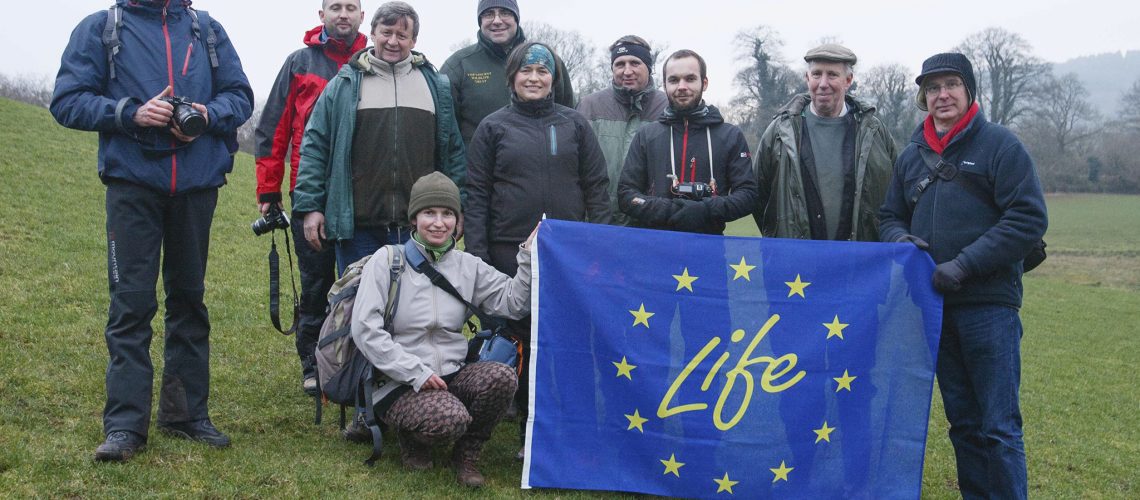
What happens when Wales, Poland and Ireland get together? Well, it seems they discuss bats, a lot!
This was the case when The Vincent Wildlife Trust hosted the project team of the Polish EU Life project Podkowiec+ in February. Seven members of the project team on a visit to some of our VWT reserves in Wales to understand what has been done to conserve lesser horseshoe bats. With the beautiful Breacon Beacons as our base we shared the work of the Trust over the past 40 years, and described how we adapted our reserves to better support lesser horseshoe colonies. We learned about the work of the project team in Poland and the similarities and differences facing lesser horseshoe conservation in Poland, Wales, England and Ireland.
Project Coordinator Rafał Szkudlarek and his team are currently undertaking an EU Life funded project in southern Poland. The main aim of Podkowiec+ is the conservation of Polish populations of highly endangered bat species, in particular the lesser horseshoe bat.
An English language version of the project website can be viewed at Podkowiec+. Part of their work entails carrying out enhancements and refurbishments of roosts – most of which are in churches, as well as increasing habitat in the surrounding landscape. However, long-term change needs a long-term view, and they are working to improve peoples’ attitudes to the lesser horseshoe bat. The result is ‘Kraina Podkowca’ – The Land of The Horseshoe Bat. The team created a promotional emblem to represent that this is a key region for lesser horseshoe bats, which is granted to enterprises, local communities, farms and people who contribute to bat conservation. A very inspiring idea!
During our time in Wales we visited five VWT reserves to look at the adaptations put in place to improve lesser horseshoe roosts, and ensure they support robust colonies. Our reserves demonstrate a wide range of work from complete reroofing and refurbishment, to modification of entrances for bats so that predators are excluded. Here are some examples of the primary adaptations to roosts and how they work.
Optimising roost temperature
Some roosts have large, open roof spaces but no ceiling. Warm air naturally rises to the apex of the roof, and this provides ideal temperatures for the lesser horseshoe bats. However, large open roof spaces encourage draughts and even the slightest draughts will mix warm and cool air, lowering the roost temperature and reducing its suitability. To overcome this we trap air to reduce draughts and maintain warm temperatures. Triangular wooden panels are used to make an airtight seal against the rafters and the wood is painted matt black to further encourage heat retention.
Hot boxes go one step further by incorporating a floor, which has an access space for bats cut into it. These features ensure that the roost provides a range of microclimates, cooler areas for when summer temperatures get too high, and warmer areas during cooler weather. This is essential to meet the varying needs of the colony. The warmest areas are most critical for the pregnant and lactating females.
The VWT installed a hanging ceiling in this listed church building, which hangs within the roof space. The lesser horseshoe bats use the space above the new ceiling. The congregation uses the church between Christmas and Easter before the bats arrive to use it as a maternity roost.
Reducing light levels
Light spillage disturbs the bats and it can also enable birds and mammalian predators to enter the roost. Blocking light is of particular importance in smaller roosts, where the bats may be quite close to the entrance. An effective method of reducing light spillage, as well as reducing draughts, is to place baffles across the entrance. The baffle is often painted black to further reflect light and attract heat.
Excluding predators
To ensure predators like cats cannot get into the roost, we often fit metal sheets below the entrances. This church porch has many beams that can be used to gain access to the church and roost space. The metal sheets stop animals getting purchase on the grooves.
Night roosts
Bats are active throughout the night and in addition to their maternity roost, they use night roosts for periods of rest. This may be important for heavily pregnant females. Night roosts are thought to provide places for grooming and to aid digestion, and can take a number of forms. For example, church porches, garden sheds and underground sites can all be used during the night for short periods of time. Below is an example of a VWT night roost with a tipping shelf to stop predators from jumping onto the sill.
Habitat enhancement
The team met with a landowner who has undertaken planting on his farm to provide habitat for lesser horseshoes foraging over this area from a nearby maternity roost. Newly planted habitat includes a hedgerow of mixed native species and two areas of wet woodland. This was of great interest to the project team, especially as they also work closely with local landowners in Poland.
It was a hugely enjoyable and very beneficial visit to all involved and the VWT looks forward to the return trip to see lesser horseshoe bat sites in Southern Poland. For now, we are continuing our lesser horseshoe bat work here in the west and south west of Ireland…perhaps in the future this will also become known as the Land of the Horseshoe Bat!